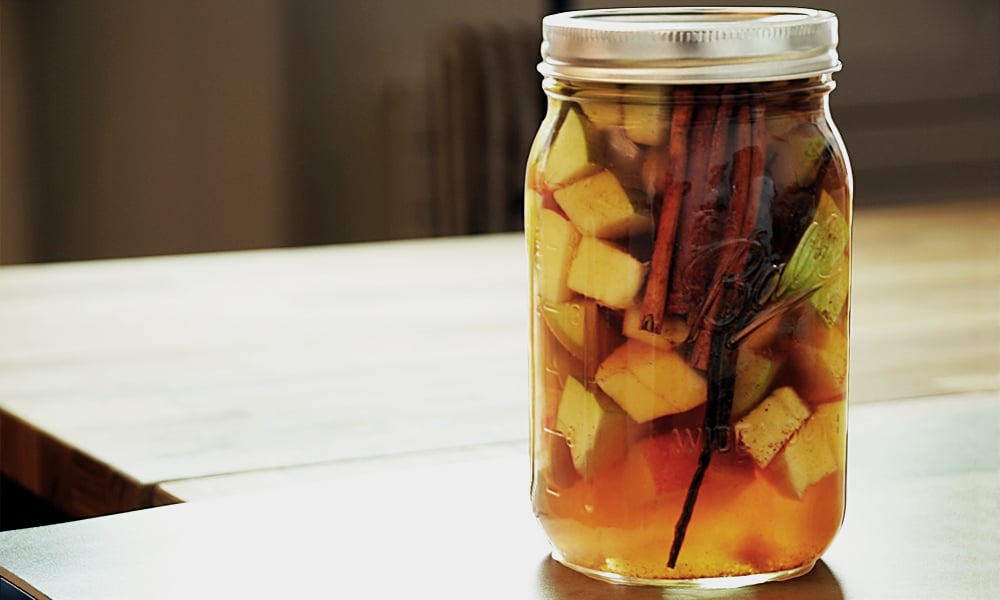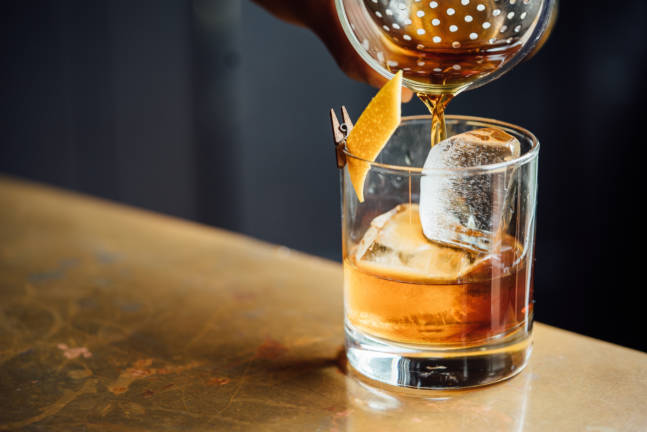The word “infusion” is appropriate. Rather than having a juice, extract, or sugar syrup that gets mixed into the spirit or cocktail, this processes fuses the flavors of whatever you’ve chosen with the deeper foundations of the drink. The same way aging whiskey in barrels changes and amplifies different aspects of the liquid’s flavor, infusions change the basic components of a spirit.
It’s a process we’re excited to see gaining more widespread use. We’ve seen it in a few cocktail bars and on a few happy hour special boards, as well as in more and more of our friends’ houses. It’s a cheaper way to enhance your understanding of mixology and impress the uninitiated amongst your friends and family. For those of you who have yet to try it or are looking to break into the game, we put together a guide on what to expect and pulled a couple of our favorite combinations to get you started.
Before we get too deep into this article, we’ll provide the more detail oriented among you with this link. It’s an exhaustive guide to infusing, with far more to say than our introductory stuff here. For those of you looking to become experts, check that one out. Us casuals will be here if you need us.
A Few Rules
Obviously, getting started, it helps to have a sense of what kind of flavors go well together. For example, we have a cucumber gin infusion coming later on the list, which is delicious. But it probably wouldn’t work as well if it was a cucumber bourbon. That’s because those smoky, woody flavors people love so much in good bourbon better lends itself to fruits and spices, not crisp summertime vegetables. But those types of flavor mixings are surprisingly instinctual. Even if you’ve never made an infusion, a good number of you probably cringed at the idea of mixing cucumber and well-made corn whiskey.
And this might go without saying, but we’re going to play it safe. Since most top shelf liquors already have a flavor all their own, they’d be better off left alone. You’re spending so much money on them, you might as well drink them the way they’re meant to be enjoyed. When you’re picking something to infuse, you’re better off with a mid-shelf spirit. Something that’s good on its own and doesn’t cost a lot of money. In fact, for those of you close enough to a Costco, this is the perfect excuse to finally visit their liquor store and try some Kirkland brand booze.
As a general rule, brown liquors like bourbon, scotch, whiskey, and brandy take non-tropical fruits very well. Take all those fruit-flavored whiskeys you’ve seen popping up on the shelves and just put the real fruit in a bottle of something better. Apples, cherries, pears, and other similar fruits do best here, as well as your favorite autumn spices. Cinnamon, nutmeg, cloves, vanilla, and coffee complement these liquors best, though you could also use them as starting points and branch out to similar spices.
Rum, since it comes in both clear and dark varieties, walks the line. Dark rums can take a few fruits but do better with spices, while clear rums take tropical fruits extremely well.
For vodka, infusions are almost insultingly simple. They have almost no distinct flavor, the way whiskeys and rums do. If you can think of something, go right ahead and try it.
Gin is more difficult. Citrus and herbs do well here, since they enhance the flavors already present in the liquor. Cucumber does as well, and it’s what we were going to suggest you try.
How-To
Making a good infusion is more about patience than any real talent. As long as you can wait the appropriate amount of time and avoid some easy mistakes, you’ll have successfully changed the flavor of your favorite whiskey, gin, vodka, rum, or whatever else might be sitting in your liquor cabinet.

As for steps, most infusions only have three: Mix, shake, and strain. You combine the ingredients at the beginning, shake the jar every once in awhile, then separate them by straining when you’re happy with your flavor. For best results, get yourself some mason jars. They’re airtight, easy to measure, and store well.
The real variable comes in with steeping time. Strong flavors like citrus, potent herbs, and things like vanilla and ginger can be done in a day or two, while some spices can take up to two weeks.
According to an article on Serious Eats, you can ballpark it. Herbs, hot peppers, vanilla, ginger, cinnamon, and citrus fruits should be done inside three days. Melons, sweet peppers, berries, and fruits with pits can be strained in about half a week. Vegetables, apples, pears, and similar fruits take a week, and dried spices need two weeks. That said, the most reliable way to tell when something’s done is to taste test. When you like what you have, you’re good to strain and drink.
The last thing is, when you strain, make sure you use something with a really fine mesh. More than one place we looked talked about cheesecloth, so find yourself some of that. Leaving large particles can change the flavor of your infusion as time goes on, which can throw off your mixing game.
Infusions to Try
Now that you have a foundation to build your infusion empire on, we have a few recommendations for you to try out first. These are some of our favorites to keep stocked in our own liquor cabinets and we hope they might find a place in your home as well. But remember, these are just a few to get you started. The possibilities for infusions aren’t quite infinite, but it’s only just that they fall short.

Apple Cinnamon Bourbon
If Fireball’s your thing, we’re not going to tell you to stop drinking it. What we will tell you is we think there are better options. Infusing a traditional bourbon with apple and cinnamon, or just cinnamon, accomplishes a lot of the same taste as Fireball, without any of the syrupy texture that keeps us away from the notorious whiskey. Plus, since you’re making it as mild or strong as you’d like, it’s easy to avoid making something that takes over drinks the way Fireball does. Plus, having a cinnamon infused bourbon on hand opens up a lot of possibilities for fall cocktails, whose time of year is very quickly approaching.
If you want a recipe, try this one. If you’d prefer to go it alone, feel free. Experimenting and making infusions to fit your own personal taste is the whole point.

Ginger Whiskey/Rum
There’s a reason whiskey and ginger ale is so many people’s introduction to the liquor. Whiskey and ginger is one of the most natural flavor matches ever conceived. But you might also find the appeal of whiskey and ginger ale waning as you get older. As a replacement, we recommend cutting out the middleman and putting them in the same jar. The infusion is well suited to people who want to drink their whiskey on the rocks, but still want some of that ginger flavor in there. Plus, infusing some ginger could allow you to double down on the root’s flavor in a few cocktails. A ginger whiskey mule brings a traditionally summertime drink into the colder months with a fairly seamless transition.
It’s the same for a spiced rum. Sometimes, what a dark and stormy needs is a little extra ginger kick. Or maybe you’re getting bored with rum and Coke, but a ginger rum would bring some new life to a tiring cocktail. For rum, the added molasses and spice can be a bit much, so mixing in ginger can freshen it up and cut some of that heavy sugar flavor.

Cucumber Gin
A few weeks ago, we found out the tradition Tom Collins is greatly improved with the addition of cucumber. The problem was, we had cucumber floating in our Tom Collins. A cucumber infused gin solved that problem handily. It’s true you lose some of the aesthetic when you remove the cucumber from a gin drink, but if you’re getting the same taste, we’re not going to complain. Plus, there are some people out there who’d much prefer to not have debris floating in their drink and really, who can blame them?

Strawberry-Basil Vodka
We mentioned above that vodka takes any infusion really well. It’s basically a blank alcoholic slate, so any flavor you add to it is going to immediately become the main feature of the mixture. For suggestions, the Huffington Post has a great list of seven versatile infusions you can make, but we’re most excited about their final pick, strawberry-basil. The thought of sipping a lemonade spiked with an infusion like that is enough that we’re hoping for a quick heat wave sometime soon. It’s a refreshing, delicious, and perfect for an afternoon when air conditioning isn’t quite cooling you off enough. Or, you know, whenever you want something strawberry and basil flavored.





